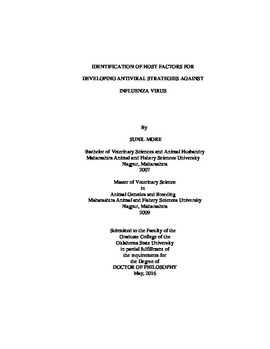| dc.contributor.advisor | Liu, Lin | |
| dc.contributor.author | More, Sunil | |
| dc.date.accessioned | 2019-08-19T15:38:39Z | |
| dc.date.available | 2019-08-19T15:38:39Z | |
| dc.date.issued | 2016-05-01 | |
| dc.identifier.uri | https://hdl.handle.net/11244/321165 | |
| dc.description.abstract | The Wnt/β-catenin signaling is an essential pathway involved in cell cycle control. Dysregulation of Wnt/β-catenin signaling pathway has been reported during viral infections. In this study, we examined the effect of modulating Wnt/β-catenin signaling during influenza virus infection. The activation of the Wnt/β-catenin pathway with Wnt3a increased mRNA expression of influenza virus genes in vitro in mouse lung epithelial E10 cells and in vivo in the lungs of mice infected with influenza virus A/Puerto Rico/8/34. However, inhibition of Wnt/β-catenin signaling with iCRT14 reduced virus titer and viral gene expression in human lung epithelial A549 cells and viral replication in primary mouse alveolar epithelial cells infected with influenza virus A/Puerto Rico/8/34 and A/WSN/1933. iCRT14 acts at the early stage of virus replication and its anti-viral activity is independent of interferon response. Treatment with iCRT14 inhibited the expression of viral genes (vRNA, cRNA and mRNA) evaluated. Intraperitoneal administration of iCRT14 reduced viral load, improved clinical symptoms, and partially protected mice from influenza virus infection. | |
| dc.description.abstract | Long non-coding RNAs (lncRNAs) are a new arm of gene regulatory mechanism as discovered by sequencing techniques and functional studies. There are only few studies on lncRNAs as related to gene expression regulation and anti-viral activity during influenza virus infection. Using RNA sequencing analysis, we found that 1,912 lncRNAs were significantly changed in human lung epithelial A549 cells infected with influenza A/Puerto Rico/8/34 along with high enrichment of type I interferon signaling and cellular response genes based on Go ontology. Seven selected up-regulated lncRNAs were verified by real-time PCR and were also induced by other two influenza H1N1 virus strains (A/WSN/1933 and A/Oklahoma/3052/09) and interferon β1. Knockdown of TAP1 and PSMB8 antisense RNA 1 (TAPSAR1) using lentiviral shRNA reduced the release of progeny influenza virus particles and inhibited viral protein synthesis but had no effects on viral mRNA level in single-cycle and multi-cycle infections. Knockdown of TAPSAR1 did not change the expression level of its neighboring gene PSMB8, but markedly reduced interferon gamma-induced protein 10 expression. Our study suggests that lncRNA TAPSAR1 could be a new host factor target for developing antiviral therapy against influenza virus infection. | |
| dc.format | application/pdf | |
| dc.language | en_US | |
| dc.rights | Copyright is held by the author who has granted the Oklahoma State University Library the non-exclusive right to share this material in its institutional repository. Contact Digital Library Services at lib-dls@okstate.edu or 405-744-9161 for the permission policy on the use, reproduction or distribution of this material. | |
| dc.title | Identification of Host Factors for Developing Antiviral Strategies Against Influenza Virus | |
| dc.contributor.committeeMember | Confer, Anthony Wayne | |
| dc.contributor.committeeMember | Oomens, Antonius G. P. | |
| dc.contributor.committeeMember | Zhang, Guolong | |
| osu.filename | More_okstate_0664D_14531.pdf | |
| osu.accesstype | Open Access | |
| dc.description.department | Veterinary Biomedical Sciences | |
| dc.type.genre | Dissertation | |
| dc.type.material | Text | |
